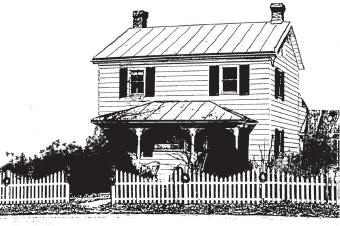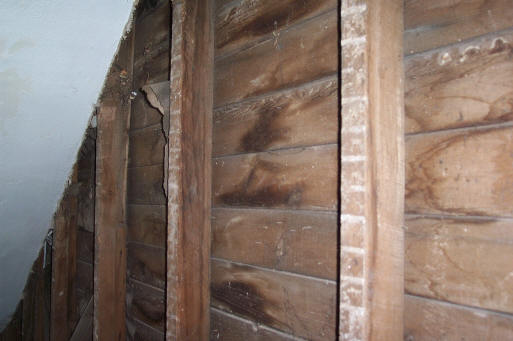|
The Old Tenant House
Michael
Hillman
Part 1
Part 2 - Inspiration
 My interest in local history all began one Christmas Eve. I was enjoying a warm fire in my study, which at one time, years ago, had served as a summer kitchen. For the prior few weeks, I had been working on a mantel-piece which was intended to be the finishing touch to a year-long renovation effort.
Made out of old fence boards, the mantel was meant to symbolize that everything, no matter how old, could still serve a purpose. My interest in local history all began one Christmas Eve. I was enjoying a warm fire in my study, which at one time, years ago, had served as a summer kitchen. For the prior few weeks, I had been working on a mantel-piece which was intended to be the finishing touch to a year-long renovation effort.
Made out of old fence boards, the mantel was meant to symbolize that everything, no matter how old, could still serve a purpose.
That evening, as I sat and admired the reflection of the flames off of the old books in the bookcases, I decided that a story on the history of the room would be interesting to do. As I was writing, it occurred to me that I knew more about the history of the Roman Empire than I knew about my house.
According to bits and pieces of stories I've heard, the house was once the tenant house for the old Bollinger family farm, and was built sometime around the turn of the last century. Outside of knowing its past owners, that's about all I knew.
Since then I've had the opportunity to interview people who once called my house home. They told stories of the outhouse that once stood on what is now my front lawn, of wood- burning kitchen stoves, and of an oil-fired heater in the living room in which Mrs. Betty Six died back in the 1940s. My old
house had witnessed much in its 120 plus years of existence. Like an archaeologist about to enter a newly discovered site, I was eager to discover what hid within its walls. Above all else, I was hoping to find some clue that could answer the first question I asked about it - when was it built?
With the plans for the kitchen renovation and addition under review by the county, I turned my attention to the original house. It was 24 feet wide, 20 feet long and two stories high. It, if anything, would hold the clues to the age of the house. According to the stories I had been told, it had two
front doors, each leading into two 12 foot by 20 foot rooms downstairs. The upstairs had one 12 foot by 20 foot room and two 12 by 10 foot rooms.
Sometime in the 1950's, Charlie Bollinger, who had owned the farm for which my house was the tenant house, moved into the house and renovated it. Charlie added all the creature comforts one wanted in those days: electricity, indoor plumbing (turning one of the original upstairs rooms into a bathroom)
and a modern hot water boiler for radiator heat. In addition, Charlie installed new flooring on top of the original floors and re-plastered the walls.
Day One: It Begins with Discoveries
Sixty years later, Charlie's plaster was cracked, windows were broken, floors were worn, and once-fine trim work an eyesore. But before I could bring down the first piece of plaster, everything had to go! Furniture, that is. All but the most critical pieces of furniture and creature comforts, e.g. the
bed, TV, and my bottles of gin and tonic, had to first get packed up and moved into the barn, where they would spend the next twelve months.
Once the old part of the house was emptied, plastic was hung between the rooms to contain dust, and the demolition began. I had no sooner taken my first few pieces of lath and plaster down when I discovered what would be the first of my insights into the house - it wasn't insulated! "No wonder," I
thought, "the house is so cold in the winter! All I have is a four-inch air gap between the outer wall and the plaster."
A few more whacks and Joe Wivell, who was guiding me in the endeavor, pointed out the second discovery: "This house was built using balloon framing. It's amazing it never burned down."
"Balloon framing? Burned down???!!!" I replied. "What????"

"When they built this house they nailed together the walls on the ground, with no spacers between the boards and then raised them like an Amish barn raising. Once the walls were up, they hung joists for the floors and rafters for the roof. It was the fastest and simplest way to put together a house,"
said Joe. "The downside of it, however, was that without any spacers between the studs in the walls, once the outer and inner walls were installed, the space between the studs formed a chimney-type flue. If a fire began, the fire would rapidly spread to the second floor. You wouldn't even know your house was on fire until
the fire broke out at the top of the wall. By then, it would be too late. By the time the fire company would get there, the house would be a torch. And given the looks of that old cloth-covered wiring, it's a wonder it didn't happen!"
I was taken aback. Living in an old house was one thing; living in a potential torch was something totally different. "OK, what do I do?"
"Not a problem," answered the savvy, farm-raised carpenter, "all we have to do is install fire breaks. Insulation will also stop the flue effect, and with new wiring, you'll be good as new."
Of course the balloon framing explained another long-standing issue I had... how were the mice getting into my bedroom ceiling? The unobstructed opening between the walls was like a major turnpike for them. Joe assured me the fire breaks would also put an end to that 18-year nuisance.
With the plaster down I could take a good look at the studs. Each bore saw marks made from a saw mill that used an Up-and-Down Saw. Up-and-Down Saws were still in use in many areas well into the 1890's, including Maxell's Saw Mill, located 300 yards North of Toms Creek Bridge. Given its location less
than a mile from my house, it's a reasonable guess that the studs for my house were cut there.

Maxell's Mill is one of the oldest mills in the Emmitsburg area. Built in 1771 as a grain mill by William Crabbs, it was known initially as Crabbs Mill. In 1845 the mill was bought by John Maxell who converted it into a saw mill. In 1859 his son Samuel took over ownership. In 1899 the mill went
bankrupt. Harry Harner converted it back to a grain mill and operated it until it closed for good in 1924. Over time all traces of it have vanished save the original mill race and a gouge in a nearby hill where the stone for the mill structure was mined. Unless you knew the history of the area, you'd never know a mill once
stood there.
So while it wasn't the written date I was hoping to find, knowing the studs had most likely come from Maxell's Mill helped to narrow down the age of the house. And as the lot the house stood on was broken off and sold to Mary Welty in 1889, and Maxell's Mill closed in 1899, the house had to have been
built in that time period, giving it an age between 110 to 120 years old.
Joe and I must have talked for hours on local history. I focused on early history, Joe on more recent history. Together we were able to put together disparate events into a coherent timeline.
To Joe's and my relief, all the studs looked as good as the day they were cut. Not a crack was seen, and no sign of any termite damage. Satisfied I had mastered the art of tearing down plaster, Joe headed off to catch up on some items at his farm. I soon found myself tripping over the debris and
decided it was time to make my first trip to the dump.
Over what seemed like an eternity, I filled five gallon buckets and emptied them into trash cans in the back of my truck. When all the trash cans were full, the dogs and I headed to the dump.
Now it had been years since I was last at the county dump, and as far as I recalled, the tipping fee was a few bucks at most. Imagine my shock when I was handed a bill for $60 for the first of what would be 60 to 70 loads. The price of gas and time it took to drive to the dump was bad enough, but $60
a load!
On the drive back all I could think of was what a mistake renovating the house was ... and wondered if it was too late to call a halt to it. I wracked my brain with a good excuse that my wife would accept.
I had no sooner pulled into the driveway when Joe returned and I lost no time in recounting my experience at the dump.
'You did what?" Joe asked, shaking his head. "Why in the world would you take plaster to the dump? All it is is lime, sand, water, and horse hair! Any farmer around here will take it for free. I meant to ask you what you were going to do with it before I left, but I forgot. So now that I know no one
has spoken for it, I want it. And I think it safe to say your truck will prefer the two block trip to my farm then the 30-mile trip to the dump."
So on the first day, Joe Wivell and I had managed to uncover and resolve the source of all the heat loss in my house, a major fire hazard, my mouse infestation issue, the age of my house, my debris problem, not to mention saving me three hours a day by eliminating the drive to the dump and $4,000 in
dumping fees! Hiring a knowledgeable Emmitsburg craftsman was already paying dividends.
I couldn't wait to see what Day Two would bring!
Read Part 3
Read
other humor stories by Michael Hillman
|